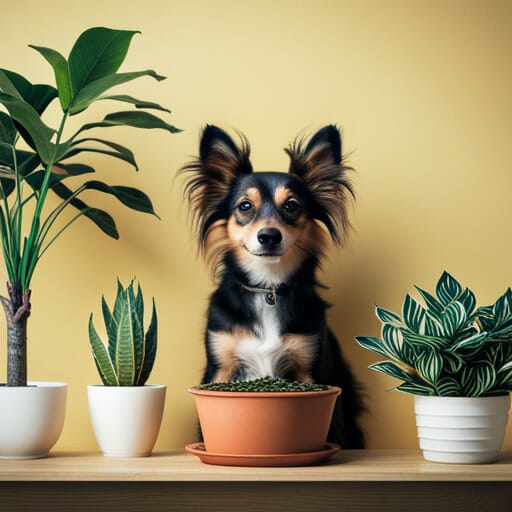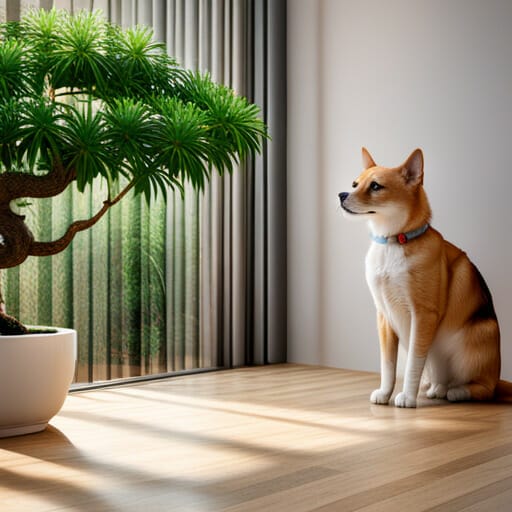Imagine creating a serene and picturesque environment in your home with the beauty of bonsai trees. These miniature trees, with their intricate branches and delicate foliage, can be a captivating addition to any living space.
However, it is crucial to consider the potential risks they pose to the health and safety of our beloved pets. Bonsai trees can harbor hidden dangers, from thorns and harmful structures that can harm pets and children, to the toxic fertilizers and pesticides used in their care.
In this article, we will explore the importance of researching the toxicity of bonsai trees, avoiding varieties that are harmful to specific pets, and implementing measures to prevent pet access to these potentially hazardous plants. By understanding the specific risks associated with bonsai tree varieties and taking the necessary precautions, we can ensure the well-being of our pets and create a safe and harmonious environment for all.
Contents
- 1 Quick Points
- 2 Pet Safety Tips
- 3 Toxic Bonsai Tree Varieties
- 4 Preventing Pet Access
- 5 Proper Care and Maintenance
- 6 Frequently Asked Questions
- 6.1 Are there any specific signs or symptoms that indicate a pet has been poisoned by a toxic bonsai tree?
- 6.2 Can reptilian pets safely interact with all types of non-toxic bonsai trees?
- 6.3 How can I ensure that my playful pets do not knock over or damage my bonsai tree?
- 6.4 Are there any specific precautions I should take when using fertilizers or pesticides on my bonsai tree to protect my pets?
- 6.5 Can I train my pets to avoid chewing on or interacting with bonsai trees?
Quick Points
- Bonsai trees can be poisonous to pets, ranging from mild allergies to severe toxicity.
- Research the toxicity of bonsai trees before bringing them into your home and avoid bonsai trees that are toxic to your specific pets.
- Some bonsai trees have thorns and structures that can harm pets and children, so avoid bonsai trees with needles and thorns if you have playful pets.
– Keep bonsai plants outdoors or out of reach of pets and supervise pets around bonsai trees that are toxic to them.
Pet Safety Tips

When it comes to protecting pets from potential toxicity, it is important to follow these pet safety tips to ensure their well-being and avoid any harm that may arise from interacting with bonsai trees.
Firstly, it is crucial to research the toxicity of bonsai trees before bringing them into your home. Different species of bonsai trees can have varying levels of toxicity, and it is important to avoid those that are toxic to your specific pets.
Additionally, if you have playful pets, it is advisable to avoid bonsai trees with needles and thorns that may harm them.
Keeping bonsai plants outdoors or out of reach of pets is another effective way to protect them.
Lastly, it is recommended to supervise pets around bonsai trees that are toxic to them to prevent any accidental ingestion.
By following these pet safety tips, you can ensure a safe environment for your pets and enjoy the beauty of bonsai trees.
Toxic Bonsai Tree Varieties

Juniper bonsai trees, specifically Chinese Juniper, Japanese Juniper, and Blue Star juniper, can pose a significant risk to the health of pets, particularly dogs, due to their toxic properties. These varieties contain substances that can cause vomiting and digestive issues when ingested by dogs. It is crucial for pet owners to be aware of the potential dangers associated with these bonsai trees and take necessary precautions to protect their furry friends.
To evoke emotion in the audience, consider the following sub-lists:
- Potential consequences of pet exposure to toxic juniper bonsai trees:
- Digestive discomfort and vomiting, leading to potential dehydration and weakness in pets.
- Increased veterinary costs and potential long-term health issues.
- Emotional distress and worry for pet owners witnessing their beloved companions suffering.
- Importance of thorough research and identification:
- Conducting thorough research on bonsai tree varieties before bringing them into the home.
- Identifying toxic juniper bonsai trees and avoiding them to ensure pet safety.
- Being vigilant about the potential risks associated with specific bonsai varieties.
- Responsible pet ownership and preventative measures:
- Keeping juniper bonsai trees out of reach of pets or in areas where they cannot access them.
- Close supervision of pets around toxic bonsai trees to prevent accidental ingestion.
- Seeking immediate veterinary care if any signs of poisoning or illness are observed.
By considering these emotional aspects and emphasizing responsible pet ownership, pet owners can ensure the safety and well-being of their beloved companions.
Learn About The Variety Of Bonsai Trees That Might Be Toxic To Your Cat
Preventing Pet Access

One effective measure to ensure the well-being of pets is to implement strategies that restrict their access to potentially harmful elements in the environment.
This is particularly important when it comes to protecting pets from toxic bonsai trees. To prevent pets from accessing these trees, several precautions can be taken.
Firstly, keeping bonsai plants outdoors or out of the reach of pets is crucial. This can be achieved by placing bonsai trees on high shelves or using barriers to block access.
Additionally, supervision is key when pets are around bonsai trees that are toxic to them. This allows for immediate intervention in case the pet shows any interest in the tree.
By following these preventive measures, pet owners can create a safe environment and minimize the risk of pets being exposed to harmful bonsai trees.
Proper Care and Maintenance

Proper care and maintenance of bonsai trees are essential factors in ensuring their longevity and overall health. To protect pets from potential toxicity, it is important to follow these guidelines:
- Regular watering: Bonsai trees require a consistent watering schedule to maintain proper hydration. Avoid overwatering as it can lead to root rot, but also ensure that the tree receives enough water to prevent dehydration, that too through an ideal watering can.
- Adequate sunlight: Bonsai trees need sufficient sunlight to thrive. Place them in a location that receives the appropriate amount of light based on their specific species requirements.
- Pruning and shaping: Regular pruning and shaping help maintain the bonsai’s desired form and prevent overgrowth. It is important to use clean and sharp tools to avoid causing damage to the tree.
By following these care and maintenance practices, bonsai trees can flourish and provide a safe environment for pets in the household.
Frequently Asked Questions
Are there any specific signs or symptoms that indicate a pet has been poisoned by a toxic bonsai tree?
Signs of pet poisoning from toxic bonsai trees include vomiting, diarrhea, stomachache, excessive drooling, troubled breathing, and changes in heart rate. Early detection and immediate veterinary care are crucial to prevent serious harm.
Can reptilian pets safely interact with all types of non-toxic bonsai trees?
Reptilian pets can safely interact with certain non-toxic bonsai trees such as Peperomia Green, Bamboo Palm, Parlor Palms, Prayer Plant, and Spruce. However, it is important to thoroughly research and ensure the specific bonsai tree is safe for reptilian pets.
How can I ensure that my playful pets do not knock over or damage my bonsai tree?
To ensure the safety of your playful pets and protect your bonsai tree from damage, consider securing the tree in a stable pot or using heavy objects to weigh it down. Additionally, placing the tree in an area out of your pets’ reach can help prevent accidents.
Are there any specific precautions I should take when using fertilizers or pesticides on my bonsai tree to protect my pets?
When using fertilizers or pesticides on bonsai trees, it is important to take precautions to protect pets. Keep pets away from treated trees until the chemicals have dried or been absorbed. Store chemicals securely and follow all safety instructions.
Can I train my pets to avoid chewing on or interacting with bonsai trees?
Pets can be trained to avoid chewing on or interacting with bonsai trees through consistent and positive reinforcement. For example, using deterrent sprays or providing alternative chew toys can redirect their behavior and protect the trees.



